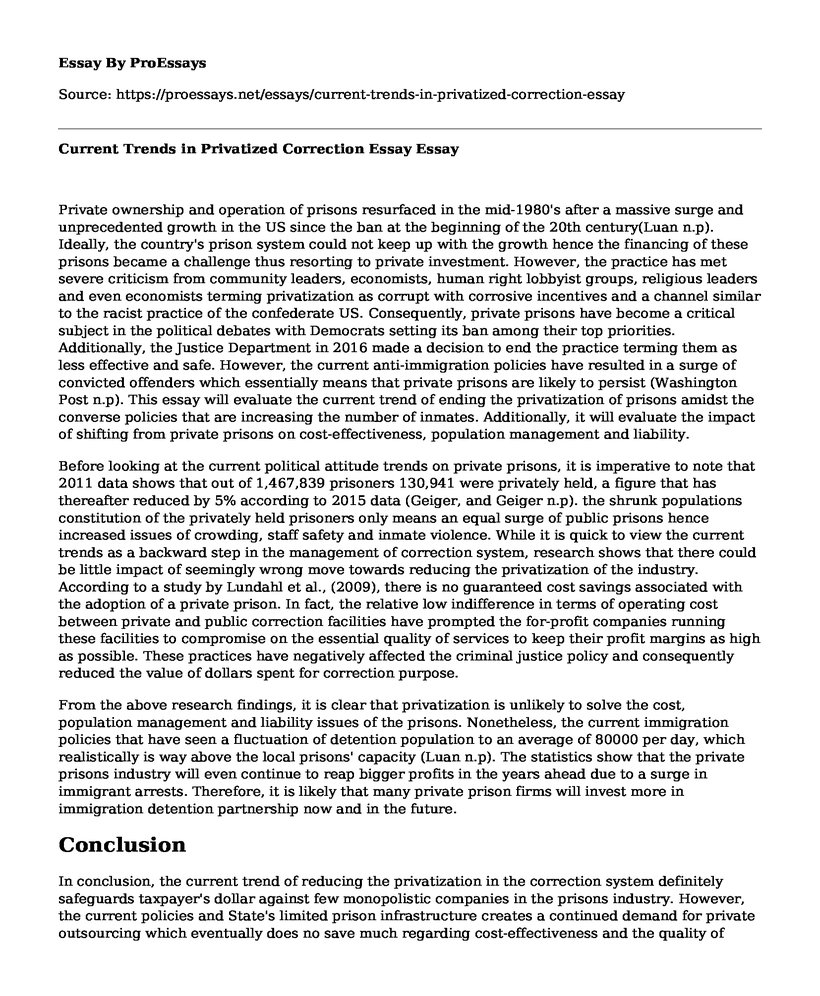Private ownership and operation of prisons resurfaced in the mid-1980's after a massive surge and unprecedented growth in the US since the ban at the beginning of the 20th century(Luan n.p). Ideally, the country's prison system could not keep up with the growth hence the financing of these prisons became a challenge thus resorting to private investment. However, the practice has met severe criticism from community leaders, economists, human right lobbyist groups, religious leaders and even economists terming privatization as corrupt with corrosive incentives and a channel similar to the racist practice of the confederate US. Consequently, private prisons have become a critical subject in the political debates with Democrats setting its ban among their top priorities. Additionally, the Justice Department in 2016 made a decision to end the practice terming them as less effective and safe. However, the current anti-immigration policies have resulted in a surge of convicted offenders which essentially means that private prisons are likely to persist (Washington Post n.p). This essay will evaluate the current trend of ending the privatization of prisons amidst the converse policies that are increasing the number of inmates. Additionally, it will evaluate the impact of shifting from private prisons on cost-effectiveness, population management and liability.
Before looking at the current political attitude trends on private prisons, it is imperative to note that 2011 data shows that out of 1,467,839 prisoners 130,941 were privately held, a figure that has thereafter reduced by 5% according to 2015 data (Geiger, and Geiger n.p). the shrunk populations constitution of the privately held prisoners only means an equal surge of public prisons hence increased issues of crowding, staff safety and inmate violence. While it is quick to view the current trends as a backward step in the management of correction system, research shows that there could be little impact of seemingly wrong move towards reducing the privatization of the industry. According to a study by Lundahl et al., (2009), there is no guaranteed cost savings associated with the adoption of a private prison. In fact, the relative low indifference in terms of operating cost between private and public correction facilities have prompted the for-profit companies running these facilities to compromise on the essential quality of services to keep their profit margins as high as possible. These practices have negatively affected the criminal justice policy and consequently reduced the value of dollars spent for correction purpose.
From the above research findings, it is clear that privatization is unlikely to solve the cost, population management and liability issues of the prisons. Nonetheless, the current immigration policies that have seen a fluctuation of detention population to an average of 80000 per day, which realistically is way above the local prisons' capacity (Luan n.p). The statistics show that the private prisons industry will even continue to reap bigger profits in the years ahead due to a surge in immigrant arrests. Therefore, it is likely that many private prison firms will invest more in immigration detention partnership now and in the future.
Conclusion
In conclusion, the current trend of reducing the privatization in the correction system definitely safeguards taxpayer's dollar against few monopolistic companies in the prisons industry. However, the current policies and State's limited prison infrastructure creates a continued demand for private outsourcing which eventually does no save much regarding cost-effectiveness and the quality of services expected for an efficient criminal justice system.
Works cited
Geiger, Abigail, and Abigail Geiger. "U.S. Private Prison Population Has Declined In Recent Years". Pew Research Center, 2018, http://www.pewresearch.org/fact-tank/2017/04/11/u-s-private-prison-population-has-declined-in-recent-years/. Accessed 5 Aug 2018.
Luan. "Profiting From Enforcement: The Role Of Private Prisons In U.S. Immigration Detention". Migrationpolicy.Org, 2018, https://www.migrationpolicy.org/article/profiting-enforcement-role-private-prisons-us-immigration-detention. Accessed 5 Aug 2018.
Lundahl, Brad W., et al. "Prison privatization: A meta-analysis of cost and quality of confinement indicators." Research on Social Work Practice 19.4 (2009): 383-394.
Washington Post, 2018, https://www.washingtonpost.com/news/post-nation/wp/2016/08/18/justice-department-says-it-will-end-use-of-private-prisons/?noredirect=on&utm_term=.e6c87be17bab. Accessed 5 Aug 2018.
Cite this page
Current Trends in Privatized Correction Essay. (2022, Jul 25). Retrieved from https://proessays.net/essays/current-trends-in-privatized-correction-essay
If you are the original author of this essay and no longer wish to have it published on the ProEssays website, please click below to request its removal:
- Developing Worlds' Markets Essay
- Digital Currency Essay Example
- Effects of Monetary Policy in Hungary Essay Example
- Vocational Rehabilitation and Re-entry Into the Workforce for the Injured Employees
- Economy of Italy Essay Example
- Essay Sample on Exploring the Balance Between Capitalism & Socialism in The United States
- Research Paper Sample on Employee Engagement







